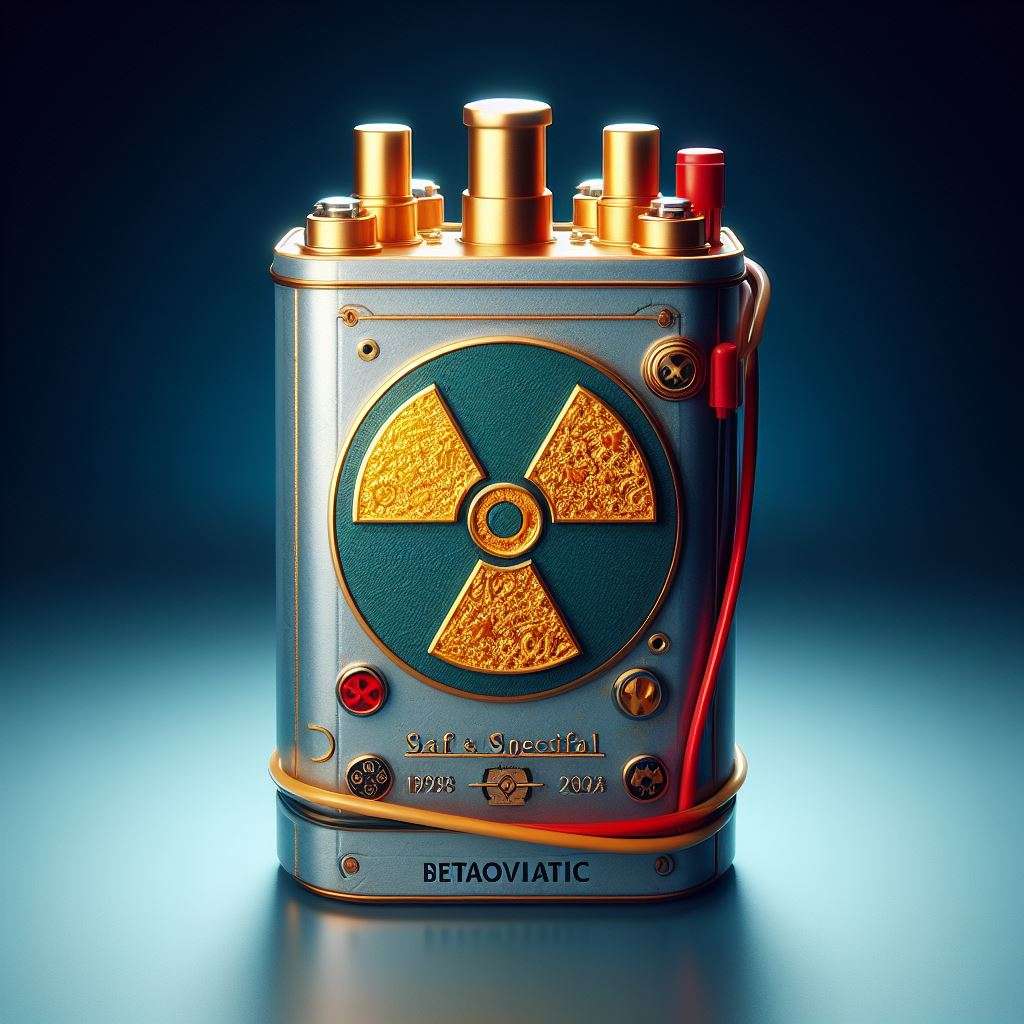The Birth of Betavoltaic Nuclear Batteries
The Birth of Betavoltaic Nuclear Batteries: In the realm of energy, it emerges as a groundbreaking innovation, harnessing the power of beta decay to generate electricity. This technology promises a long-lasting and stable power source, revolutionizing how we think about batteries and energy storage.
Table of Contents
Understanding Betavoltaic Batteries
Under the hood of a betavoltaic battery lies a surprising marriage of nuclear technology and the principles behind solar cells. Unlike traditional batteries that rely on chemical reactions, betavoltaics harness the energy released during the radioactive decay of certain isotopes. These isotopes, like tritium, emit tiny particles called beta particles.
Inside the battery, a layer of semiconductor material acts like a tiny solar panel. As beta particles zip through the semiconductor, they knock electrons loose from their atoms. This creates an electric field, similar to how sunlight does in a solar cell. This electric field is then channeled to create a weak but continuous electrical current.
Betavoltaic batteries boast impressive lifespans, lasting for decades due to the constant, long-lasting nature of radioactive decay. While they currently produce low power, research is ongoing to improve their efficiency and power output. This unique technology has the potential to power low-power devices in remote or difficult-to-reach locations for extended periods, making them a game-changer in various fields.
Manufacturers of Betavoltaic Batteries (The Birth of Betavoltaic Nuclear Batteries)

The manufacturing landscape for these batteries is still nascent, with a limited number of players at the forefront. However, these companies are making significant strides in developing and commercializing this innovative technology.
One leading manufacturer is City Labs, Inc. They specialize in designing and manufacturing tritium-based betavoltaic batteries. Their focus lies on applications in aerospace, defense, medical devices, and other demanding industries. Their NanoTritium™ technology boasts long lifespans exceeding traditional batteries, making them ideal for situations where replacing batteries is impractical or risky.
Other companies like BetaBatt and Widetronix are also emerging in this space. With continued research and development efforts, we can expect its market to expand, attracting more players and fostering advancements in production techniques and efficiency. This will ultimately lead to a wider range of these battery options and a more robust supply chain for this promising technology.
The Historical Journey of Nuclear Batteries
The concept of nuclear batteries, harnessing the power of the atom for long-term energy, has captivated scientists for decades. Their journey, however, is a story of both remarkable progress and persistent challenges.
Early Glimmers (1910s-1950s): The seeds of the idea were sown in the early 20th century with the discovery of radioactivity. Scientists like Henry Moseley theorized about using radioactive materials to generate electricity. The 1940s saw the development of the first nuclear reactors, further fueling the dream of nuclear-powered batteries. However, the technology of the time struggled to efficiently convert radioactive decay into usable electricity.
Dawn of Betavoltaics (1960s-1980s): The 1960s marked a turning point with the advent of betavoltaic technology. These batteries utilized the low-energy emissions of beta particles from decaying isotopes to create a small electric current. Early applications emerged in space exploration, powering pacemakers, and providing electricity in remote lighthouses.
Challenges and Advancements (1990s-Present): Despite initial promise, its development faced hurdles. The power output remained low, limiting their applications. Additionally, concerns around radioactive material handling and disposal presented regulatory challenges. However, recent decades have seen renewed interest. Advancements in materials science and miniaturization techniques have led to more powerful and efficient betavoltaic designs. Research continues to improve energy density and explore alternative isotopes for a wider range of applications.
The Road Ahead: Today, these batteries are still in their early stages of commercialization. While not yet replacements for everyday batteries, they offer a unique solution for powering low-power devices in remote or long-term applications. The future of nuclear batteries hinges on overcoming cost hurdles and navigating regulatory landscapes. However, with continued research and development, this technology has the potential to revolutionize how we power various devices, ushering in a new era of long-lasting, reliable, and low-maintenance energy.
Advancements in Betavolt Technology
Betavoltaic batteries hold immense promise for powering low-power devices for extended periods. However, to fully realize this potential, researchers are actively making strides in several key areas:
1. Boosting Power Output: One of the primary challenges with betavoltaics is their currently low power output, measured in microwatts. Researchers are exploring avenues to improve efficiency. This includes:
- Advanced Semiconductor Materials: Developing new semiconductor materials that can better capture and convert the energy of beta particles into electricity is a key area of focus.
- Nanotechnology: Utilizing nanostructures within the battery can improve the interaction between beta particles and the semiconductor, leading to a more efficient flow of electricity.
2. Miniaturization and Integration: Advancements in miniaturization techniques are allowing for the creation of even smaller betavoltaic batteries. This opens doors for powering miniaturized medical devices or integrating them into microelectronics.
3. Alternative Isotopes: Tritium is the most common isotope used in these batteries due to its safe, low-energy beta emissions. However, researchers are exploring other isotopes that might offer a better balance between power output and safety characteristics.
4. Cost Reduction: Currently, production costs for these batteries are high. Optimizing manufacturing processes and developing scalable production techniques are crucial for bringing down the price and making this technology more commercially viable.
The Payoff: These advancements hold the promise of significant benefits. Imagine medical implants powered by betavoltaic batteries that last for the lifetime of the patient, eliminating the need for risky replacement surgeries. Or consider remote sensor networks in harsh environments, powered for years without maintenance. As betavoltaic technology continues to evolve, these exciting possibilities inch closer to reality.
Q&A Section
- How do betavoltaic batteries work?
They use beta particles from radioactive decay to create an electric current within a semiconductor material, similar to a solar cell using light. - Who are some of the manufacturers of betavoltaic batteries?
Companies like City Labs are leaders in this space, but the field is still emerging. - Can you tell me about the history of nuclear batteries?
The concept stretches back to the early 20th century, but recent advancements in materials science are driving the development of betavoltaic technology. - Is there a new type of battery in betavoltaic technology?
There isn’t one specific “new” battery, but ongoing research focuses on improving efficiency and miniaturization for next-generation betavoltaics.
Conclusion
Betavoltaic batteries, with their marriage of nuclear science and solid-state physics, illuminate a path towards a future powered by long-lasting, low-maintenance energy. Imagine a world where tiny, unobtrusive batteries silently hum with life for decades, powering medical devices that seamlessly integrate with the body, or environmental sensors that stand vigilant in remote locations. Betavoltaic technology is still in its nascent stages, but the potential for a cleaner, more sustainable future beckons. With continued research and development, these tiny powerhouses have the potential to revolutionize how we interact with low-power devices, ushering in an era of energy independence and innovation.
Also Read:
Betavolt’s Nuclear Battery: A Revolutionary Power Source for the Future





